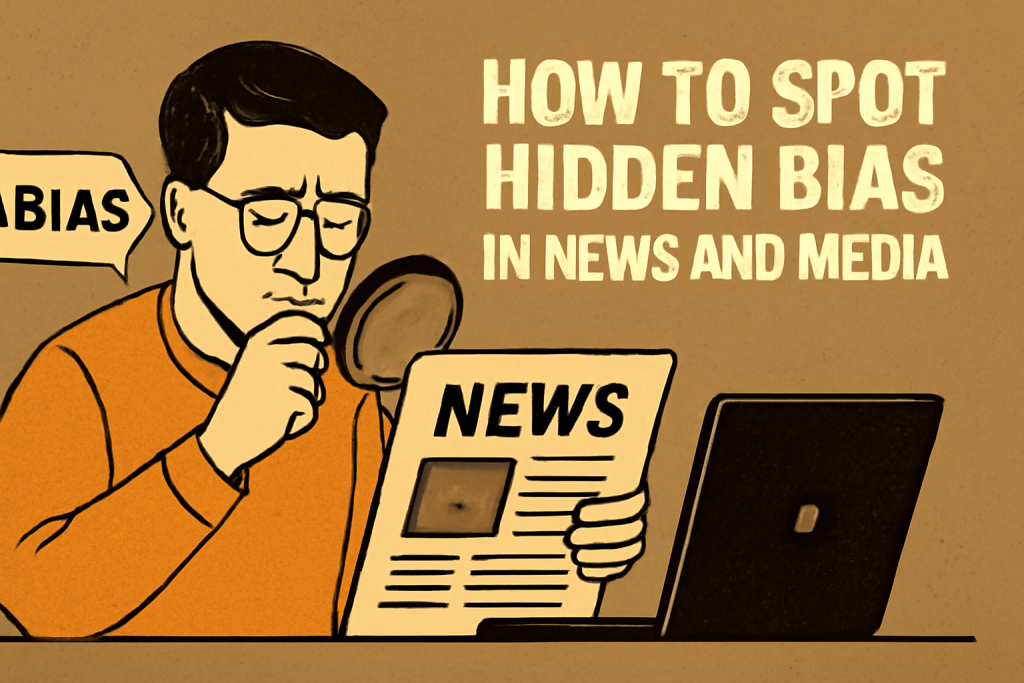In today’s world, the news and media play an essential role in shaping public opinion and informing decisions. Readers often encounter a persistent challenge: hidden bias in news and media sources. Hidden bias shapes how we present information, potentially swaying perceptions without the audience realizing it. Understanding how to spot hidden bias in news and media is crucial for anyone seeking accurate, balanced information in an age of widespread misinformation and polarized viewpoints.
This article provides a clear, practical guide on how to identify hidden bias in news and media, using current trends and research to help you become a more discerning consumer of information.

What Does Hidden Bias in News and Media Mean?
Bias subtly influences how news stories select, frame, or present information, often favoring or prejudicing certain viewpoints unintentionally. Unlike explicit bias, which openly states its position, hidden bias operates beneath the surface, shaping audience attitudes by affecting tone, language, and emphasis.
Examples include:
- Selective story coverage that highlights one viewpoint while ignoring others.
- Use of emotionally charged language that favors or discredits particular subjects.
- Imbalanced quoting of sources, privileging certain voices over others.
Identifying hidden bias requires more than just reading headlines; it involves critical thinking and awareness of the mechanisms by which media can shape narratives.
Why Spotting Hidden Bias in News and Media Matters Today
The rise of social media and digital news platforms has dramatically increased the volume and variety of information sources available. While this offers greater access, it also creates fertile ground for biased or misleading content to spread quickly.
According to a 2023 Pew Research Center study, 68% of adults in the U.S. say made-up news causes a great deal of confusion about basic facts of current events.1 Being able to spot hidden bias helps readers:
- Avoid being misled or manipulated.
- Make informed decisions based on balanced perspectives.
- Encourage higher journalistic standards through critical consumption.
How to Spot Hidden Bias in News and Media: 7 Practical Steps
Here are practical methods to identify hidden bias in the news you consume:
1. Examine the Source’s Reputation and Ownership
- Research who owns the media outlet. Corporate or political affiliations can influence editorial decisions.
- Check if the outlet has a track record of balanced reporting or has been flagged for bias.
Tip: Use tools like Media Bias/Fact Check2 or AllSides3 to assess the bias and reliability of news sources.
2. Analyze the Headlines and Language
- Notice if headlines use sensational or emotionally charged words.
- Look for language that suggests judgment rather than objective reporting (e.g., “radical,” “alleged,” “heroic”).
- Compare headlines across different sources covering the same story to spot differences in framing.
3. Check for Balance in Coverage
- Evaluate whether multiple perspectives are presented fairly.
- Notice if opposing viewpoints are dismissed or ignored.
- See if the article quotes experts or credible sources from diverse sides.
4. Identify Loaded or Leading Questions in Interviews
- Pay attention to whether questions asked in interviews are neutral or leading.
- Leading questions can push interviewees toward a particular response, which biases the content.
5. Observe Visuals and Placement
- Be aware that photos, videos, or graphics can convey bias by emphasizing certain aspects or emotions.
- Notice if stories with a particular slant get more prominent placement or frequent coverage.
6. Cross-Verify Facts and Data
- Don’t rely on a single source. Cross-check key facts, statistics, and quotes with multiple reputable outlets.
- Look for data that is cited properly, with transparent methodology.
7. Reflect on Your Own Bias
- Everyone has personal biases that affect interpretation.
- Being aware of your own beliefs can help you recognize when a story is designed to confirm those beliefs, known as confirmation bias.
Emerging Trend: AI and Algorithmic Influence on Media Bias
A current hot topic is the role of artificial intelligence (AI) and algorithms in shaping what news content is presented to users. Platforms like Facebook, Twitter, and Google use algorithms designed to maximize engagement, which can inadvertently amplify biased or sensational content.
Recent research from the Reuters Institute highlights that algorithmic filtering often creates “filter bubbles,” where users are repeatedly shown content that reinforces their existing views.4 This trend makes it even more important to actively seek diverse sources and critically evaluate media.
Tools and Resources to Help Spot Hidden Bias in News and Media
Several tools have emerged to help readers identify bias and verify news:
- Fact-Checking Websites: Snopes, FactCheck.org, and PolitiFact provide verified analysis of claims and news stories.
- Bias Assessment Platforms: AllSides offers media bias ratings and explanations.
- Browser Extensions: Tools like NewsGuard provide ratings and warnings about source reliability directly on your browser.
Using these tools regularly can improve media literacy and reduce the impact of hidden bias.
Conclusion: Becoming a More Critical Media Consumer
Learning how to spot hidden bias in news and media is essential in the current information environment. By evaluating sources, language, balance, and your own perspective—and by using available fact-checking tools—you can better navigate the complex media landscape.
This skill not only improves your understanding but contributes to a healthier information ecosystem overall.
References
- Pew Research Center. (2023). Americans See Made-Up News as a Major Problem. Retrieved from https://www.pewresearch.org/journalism/2023/01/26/americans-see-made-up-news-as-major-problem/ ↩
- Media Bias/Fact Check. Media Bias Ratings. https://mediabiasfactcheck.com/ ↩
- AllSides. Media Bias Ratings. https://www.allsides.com/media-bias/media-bias-ratings ↩
- Reuters Institute. (2024). Digital News Report 2024. University of Oxford.






